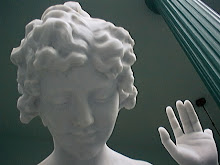Imagine standing in the longest line ever, only it never ends. Like being at WalMart, but not only does your hair look really good, so does everybody elses. And WalMart kills your hairdresser. This is something like what it must have been like to be an actual terracotta soldier as currently represented by the exhibit at the High Museum,
The First Emperor: China's Terracotta Army. The story of the seven thousand uniquely sculpted soldiers that were buried forgotten on a plain for 2,000 years is truly amazing, and the brilliant and systematic efficiency of the ruler
Qin Shi Huang, the First
Emperor of China, produced powerful, lasting effects on the country, and yet, this traveling exhibit which originated at the British Museum manages to summarize, pre-digest, and commodify the complex history without mentioning words like slave, mass murder, or forced labor. But first, you have to pay 18 dollars for admission plus five dollars for the audio tour, which does briefly admit in passing the possibility that the "conscripted workers" could be considered to have been, well, slaves. The extremely minimal content that is imparted in text and on tape would together fill up one side of a cereal box. Why not just charge an even 25 dollars and throw in a pamphlet? By the time you are released into the gift shop of overpriced Chinese knick knacks, you are either programmed to purchase the complete set of miniature replica terracotta soliders, a must-have at the post-Christmas bargain price of $25.00, or worse, you will convince yourself that you need to get a full-size version.
The amount of money that is being made from this exhibit does not seem to be reflected in the content or cultural scholarship that surrounds it. From an article about the terracotta soldiers in
Wikipedia:
"According to The Times, many people had to be turned away from the exhibition, despite viewings until midnight, and during the day of events to mark the Chinese new year, the crush was so intense that the gates to the museum had to be shut. The Terracotta Army has been described as the only other set of historic artifacts (along with the remnants of ruins of the Titanic) which can draw a crowd simply on the back of the name alone."
People are deeply interested in these artifacts. Is their attention span sufficient to stand in line to look, but not to think deeply about all of the facts surrounding their creation? It's as if an exhibit in 2000 years focused primarily on Hitler's development of the autobahns and didn't mention the Holocaust. DisneyWorld charges admission for an experience that entertains and diverts, while providing opportunities to separate you from your money for every little thing. Aren't museums supposed to do more than that?
The period of
Qin Shi Huang's unification of China is also known as the "
burning of the books and burial of the scholars," which sounds just like it was. Perhaps the not-quite-yet-to-materialize Shanghai Disney will offer a thrilling adventure ride modeled on the
Cultural Revolution. Great fun for the family!
 Reese Street
Reese Street





